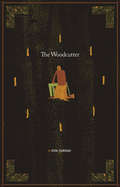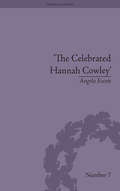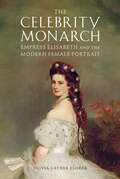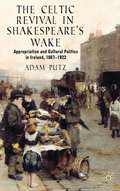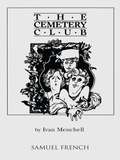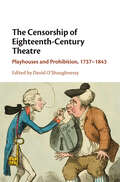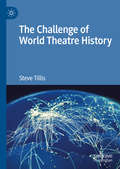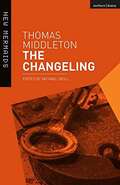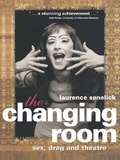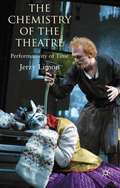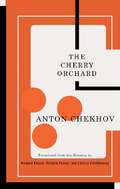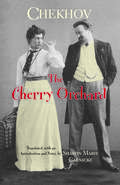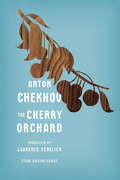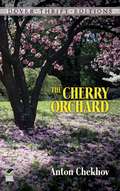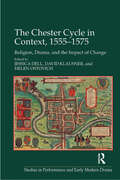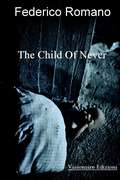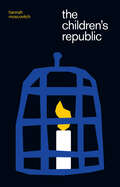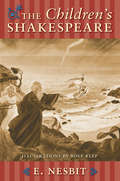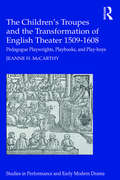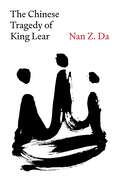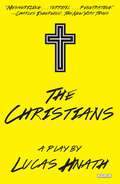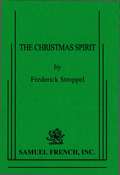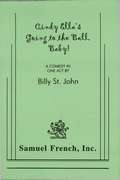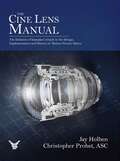- Table View
- List View
The Cave Painter & The Woodcutter
by Don HannahDianne is a printmaker who derives her imagery from pre-history—Neanderthal teeth, the Jericho skulls, old bones. Too many people close to her have passed away, and her only son has rebelled by embracing a life of religious fundamentalism. The Cave Painter is a funny, moving one-woman show about being an artist and dealing with loss. In The Woodcutter, a scruffy, exhausted man is lost in the woods at nightfall with only a few sentimental objects in his pockets. Alone in a clearing, he unloads his thoughts to the surrounding wilderness, ranting and raging, unravelling a story of a troubled past and of the family he adores, eventually coming to terms with the impossible truth of what he's done.
The Celebrated Hannah Cowley: Experiments in Dramatic Genre, 1776–1794 (Gender and Genre)
by Angela EscottHannah Cowley (1743–1809) was a very successful dramatist, and something of an eighteenth-century celebrity. New critical interest in the drama of this period has meant a resurgence of interest in Cowley’s writing and in the performance of her plays. This is the first substantial monograph study to examine Cowley’s life and work.
The Celebrity Monarch: Empress Elisabeth and the Modern Female Portrait (Performing Celebrity)
by Olivia Gruber FlorekEmpress Elisabeth of Austria (1837-1898), wife of Habsburg Emperor Francis Joseph I, was celebrated as the most beautiful woman in Europe. Glamorous painted portraits by Franz Xaver Winterhalter and widely collected photographs spread news of her beauty, and the twentieth-century German-language film trilogy Sissi (1955-57) cemented this legacy. Despite the enduring fascination with the empress, art historians have never considered Elisabeth’s role in producing her public portraiture or the influence of her creation. The Celebrity Monarch reveals how portraits of Elisabeth transformed monarchs from divinely appointed sovereigns to public personalities whose daily lives were consumed by spectators. With resources ranging from the paintings of Gustav Klimt and Elisabeth’s private collection of celebrity photography to twenty-first century collages and films by T. J. Wilcox, this book positions Elisabeth herself as the primary engineer of her public image and argues for the widespread influence of her construction on both modern art and the emerging phenomenon of celebrity.
The Celtic Revival in Shakespeare’s Wake
by Adam PutzThis book reconsiders the Celtic Revival by examining appropriations of Shakespeare, using close readings of works by Arnold, Dowden, Yeats and Joyce to reveal the pernicious manner in which the discourse of Anglo-Irish cultural politics informed the critical paradigms that mediated the reading of Shakespeare in Ireland for a generation.
The Cemetery Club
by Ivan MenchellIvan MenchellComedyCharacters: 1 male, 5 femaleMultiple SetsThree Jewish widows meet once a month for tea before going to visit their husband's graves. Ida is sweet tempered and ready to begin a new life, Lucille is a feisty embodiment of the girl who just wants to have fun, and Doris is priggish and judgmental, particularly when Sam the butcher enters the scene. He meets the widows while visiting his wife's grave. Doris and Lucille squash the budding romance between Sam and Ida. They are guilt stricken when this nearly breaks Ida's heart. The Broadway production starred Eileen Heckart as Lucille."Funny, sweet tempered, moving." -Boston Globe"Very touching and humorous. An evening of pure pleasure that will make you glad you went to the theatre."-Washington Journal Newspapers
The Censorship of Eighteenth-Century Theatre: Playhouses and Prohibition, 1737–1843
by David O’ShaughnessyThis collection reveals the wide-ranging impact of the Stage Licensing Act of 1737 on literary and theatrical culture in Georgian Britain. Demonstrating the differing motivations of the state in censoring public performances of plays after the Stage Licensing Act of 1737 and until the Theatres Act 1843, chapters cover a wide variety of theatrical genres across a century and show how the mechanisms of formal censorship operated under the Lord Chamberlain's Examiner of Plays. They also explore the effects of informal censorship, whereby playwrights, audiences and managers internalized the censorship regime. As such, the volume moves beyond a narrow focus on erasures and emendations visible on manuscripts to elucidate censorship's wide-ranging significance across the long eighteenth century. Demonstrating theatre archives' potency as a resource for historical research, this volume is of exceptional value for researchers interested in the evolving complexities of Georgian society, its politics and mores.
The Challenge of World Theatre History
by Steve TillisThe future of theatre history studies requires consideration of theatre as a global phenomenon. The Challenge of World Theatre History offers the first full-scale argument for abandoning an obsolete and parochial Eurocentric approach to theatre history in favor of a more global perspective. This book exposes the fallacies that reinforce the conventional approach and defends the global perspective against possible objections. It moves beyond the conventional nation-based geography of theatre in favor of a regional geography and develops a new way to demarcate the periods of theatre history. Finally, the book outlines a history that recognizes the often-connected developments in theatre across Eurasia and around the world. It makes the case that world theatre history is necessary not only for itself, but for the powerful comparative and contextual insights it offers to all theatre scholars and students, whatever their special areas of interest.
The Changeling: Revised Edition (New Mermaids)
by Michael Neill Thomas Middleton William Rowley“The next good mood I find my father in, I'll get him quite discarded” <p><p> With these chillingly offhand words, Beatrice-Joanna, the spoilt daughter of a powerful nobleman, plots to get rid of the family servant who has crossed her once too often. The Changeling's vivid tale of sexual appetite, repulsion, betrayal and lunacy remains one of the most compelling tragedies of the 17th century. Exposing the vexed relationship between servants and masters, setting notions of `change' against the revelation of psychological 'secrets' as ways of explaining human behaviour, and exploring the idea of love as a `tame madness', the play reveals the terrifying consequences of ungoverned sexual appetite and betrayal. Featuring the full and modernized play text, this revised edition includes incisive commentary notes which explain the nuances of the play's vibrant, colloquial language and demonstrate its sly delight in the characters' conscious and unconscious wordplay. Michael Neill's illuminating introduction provides a firm grounding in the play's socio-political context, demonstrates how careful close-reading can expand your enjoyment of the play, explains the play's violent linkage of comic and tragic plots and gives theatrical life to the text via a discussion of its stage history, with a particular emphasis on the most interesting recent productions. <p><p> The New Mermaids plays offer: · Modernized versions of the play text edited to the highest textual standards · Fully annotated student editions with obscure words explained and critical, contextual and staging insight provided on each page · Full Introductions analyzing context, themes, author background and stage history
The Changing Room: Sex, Drag and Theatre (Gender in Performance)
by Laurence SenelickThe answers to these questions - and much, much more - are to be found in The Changing Room , which traces the origins and variations of theatrical cross-dressing through the ages and across cultures. It examines: * tribal rituals and shamanic practices in the Balkans and Chinese-Tibet * the gender-bending elements of Greek and early Christian religion * the homosexual appeal of the boy actor on the traditional stage of China, Japan and England * the origins of the dame comedian, the principal boy, the glamour drag artiste and the male impersonator * artists such as David Bowie, Boy George, Charles Ludlam, Dame Edna Everage, Lily Savage, Candy Darling, Julian Clary and the New York Dolls. Lavishly illustrated with unusual and rare pictures, this is the first ever cross-cultural study of theatrical transvestism. It is a must for anyone interested in cross-dressing, theatre, and gender.
The Chemistry of the Theatre
by Jerzy LimonThis innovative, theoretical work focuses on temporal issues in theatre and the 'chemistry' of theatre - the ways in which a variety of factors in performance combine to make up what we call 'theatre'. Discussing a range of canonical plays, from Shakespeare to Beckett, the book makes a unique contribution to theatre and performance studies.
The Cherry Orchard
by Anton Chekhov Larissa Volokhonsky Richard Pevear Richard Nelson"Pevear and Volokhonsky are at once scrupulous translators and vivid stylists of English."--The New YorkerThere have always been two versions of Chekhov's heartrending and humorous masterwork: the one with which we are all familiar, staged by Konstatine Stanislavski at the Moscow Art Theatre in 1904, and the one Chekhov had originally envisioned. Now, for the first time, both are available and published here in a single volume in translations by the renowned playwright Richard Nelson and Richard Peavar and Larissa Volokhonsky, the foremost contemporary translators of classic Russian literature. Shedding new light on this most revered play, the translators reconstructed the script Chekhov first submitted and all of the changes he made prior to rehearsal. The result is a major event in the publishing of Chekhov's canon.Richard Nelson's many plays include Rodney's Wife, Goodnight Children Everywhere, Drama Desk-nominated Franny's Way and Some Americans Abroad, Tony Award-nominated Two Shakespearean Actors and James Joyce's The Dead (with Shaun Davey), for which he won a Tony Award for Best Book of a Musical, and the critically acclaimed, searing play cycle, The Apple Family Plays.Richard Pevear and Larissa Volokhonsky have produced acclaimed translations of Leo Tolstoy, Fyodor Dostoevsky, Nikolai Gogol, Anton Chekhov, and Mikhail Bulgakov. Their translations of The Brothers Karamazov and Anna Karenina won the 1991 and 2002 PEN/Book-of-the-Month Club Translation Prizes. Pevvear, a native of Boston, and Volokhonsjky, of St. Petersburg, are married to each other and live in Paris.
The Cherry Orchard
by Anton Chekhov Sharon Marie CarnickeDrawn from Sharon Marie Carnicke's volume of Chekhov, Four Plays and Three Jokes (Hackett), this edition of The Cherry Orchard features Carnicke's groundbreaking translation of a play that has been called Chekhov's ultimate theatrical coup d'etat.** Donald Rayfield, The Cherry Orchard: Catastrophe and Comedy
The Cherry Orchard
by Anton Chekhov Laurence Senelick<P>Anton Chekhov is a unique force in modern drama, his works cherished for their brilliant wit and insight into the human condition. <P>In this stunning new translation of one of Chekhov's most popular and beloved plays, Laurence Senelick presents a fresh perspective on the master playwright and his groundbreaking dramas. <P>He brings this timeless trial of art and love to life as memorable characters have clashing desires and lose balance in the shifting eruptions of society and a modernizing Russia. <P>Supplementing the play is an account of Chekhov's life; a note on the translation; an introduction to the work; and variant lines, often removed due to government censorship, which illuminate the context in which they were written. <P>This edition is the perfect guide to enriching our understanding of this great dramatist or to staging a production.
The Cherry Orchard
by Anton ChekhovThe Cherry Orchard was first produced by the Moscow Art Theatre on Chekhov's last birthday, January 17, 1904. Since that time it has become one of the most critically admired and performed plays in the Western world, a high comedy whose principal theme, the passing of the old semifeudal order, is symbolized in the sale of the cherry orchard owned by Madame Ranevsky.The play also functions as a magnificent showcase for Chekhov's acute observations of his characters' foibles and for quizzical ruminations on the approaching dissolution of the world of the Russian aristocracy and life as it was lived on their great country estates. While the subject and the characters of the work are, in a sense, timeless, the dramatic technique of the play was a Chekhovian innovation. In this and other plays he developed the concept of "indirect action," in which the dramatic action takes place off stage and the significance of the play revolves around the reactions of the characters to those unseen events.Reprinted from a standard edition, this inexpensive well-made volume invites any lover of theater or great literature to enter the world of Madame Ranevsky, Anya, Gayef, Lopakhin, Firs, and the other memorable characters whose hopes, fears, loves, and general humanity are so brilliantly depicted in this landmark of world drama.
The Chester Cycle in Context, 1555-1575: Religion, Drama, and the Impact of Change (Studies in Performance and Early Modern Drama)
by Jessica Dell David KlausnerThe Chester Cycle in Context, 1555-1575 considers the implications of recent archival research which has profoundly changed our view of the continuation of performances of Chester's civic biblical play cycle into the reign of Elizabeth I. Scholars now view the decline and ultimate abandonment of civic religious drama as the result of a complex network of local pressures, heavily dependent upon individual civic and ecclesiastical authorities, rather than a result of a nation-wide policy of suppression, as had previously been assumed.
The Child of Never
by Federico RomanoThe great journey that Frederik Jonson will make to the heavenly kingdom will open the way for him on the origin and truth of his life. Through a varied gallery of characters - human fauna of defenceless victims or executioners, wicked murderers or innocents, men devoted to excesses and perditions or innocent unconscious people - an extraordinary epiphany of greatness will take place: the revelation of Frederik's destiny and the eschatological passage from "child of never" to man from generous existence to heroism.
The Children's Republic
by Hannah MoscovitchConfined within the walls of the Warsaw Ghetto, Dr. Janusz Korczak struggles to protect the children at his orphanage from the horrors of the Second World War. There is not enough food or pairs of eyes to keep watch over them. Between a troublemaking thief, an abandoned girl, a malnourished boy, and a violin prodigy, Janusz has his hands full, but together they fight for beauty and hope in a world crumbling around them. Based on the WWII advocacy work of Dr. Janusz Korczak, The Children’s Republic is a reminder of the hope that can still be found in a world devoid of freedom and the necessities of life.
The Children's Shakespeare
by Edith NesbitThe acclaimed children&’s author shares vibrant retellings of the Bard&’s timeless tales in this classic, illustrated collection for young readers. As both a writer and a mother, E. Nesbit wanted an engaging way to share the great works of Shakespeare with children. In The Children&’s Shakespeare, she adapted eleven of his plays—including Hamlet, Twelfth Night, A Midsummer Night&’s Dream, and others—into accessible stories that creatively capture all the essential elements. The Children&’s Shakespeare offers an ideal introduction to these works, simply told yet preserving their wit, humor, emotion, and drama. In E. Nesbit's gifted hands, these stories emerge with all the charm and grace of the very best fairy tales. Written in modern English and each no more than ten pages in length, the eleven plays featured in this volume afford children the opportunity to discover the magic of Shakespeare for themselves
The Children's Troupes and the Transformation of English Theater 1509-1608: Pedagogue, Playwrights, Playbooks, and Play-boys (Studies in Performance and Early Modern Drama)
by Jeanne McCarthyThe Children’s Troupes and the Transformation of English Theater 1509–1608 uncovers the role of the children’s companies in transforming perceptions of authorship and publishing, performance, playing spaces, patronage, actor training, and gender politics in the sixteenth century. Jeanne McCarthy challenges entrenched narratives about popular playing in an era of revolutionary changes, revealing the importance of the children’s company tradition’s connection with many early plays, as well as to the spread of literacy, classicism, and literate ideals of drama, plot, textual fidelity, characterization, and acting in a still largely oral popular culture. By addressing developments from the hyper-literate school tradition, and integrating discussion of the children’s troupes into the critical conversation around popular playing practices, McCarthy offers a nuanced account of the play-centered, literary performance tradition that came to define professional theater in this period. Highlighting the significant role of the children’s company tradition in sixteenth-century performance culture, this volume offers a bold new narrative of the emergence of the London theater.
The Chinese Tragedy of King Lear
by Nan Z. DaA compelling new reading of The Tragedy of King Lear that finds parallels in twentieth-century Chinese historyAt the start of Shakespeare&’s famous tragedy, King Lear promises to divide his kingdom based on his daughters&’ professions of love, but portions it out before hearing all of their answers. For Nan Da, this opening scene sparks a reckoning between The Tragedy of King Lear, one of the cruelest and most confounding stories in literature, and the tragedy of Maoist and post-Maoist China. Da, who emigrated from China to the United States as a child in the 1990s, brings Shakespeare&’s tragedy to life on its own terms, addressing the concerns it reflects over the transition from Elizabeth I to James I with a fearsome sense of what would soon come to pass. At the same time, she uses the play as a lens to revisit the world of Maoist China—what it did to people, and what it did to storytelling. Blending literary analysis and personal history, Da begins in her childhood during Deng Xiaoping&’s Opening and Reform, then moves back and forth between Lear and China. In her powerful reading, the unfinished business of Maoism and other elements of Chinese thought and culture—from Confucianism to the spectacles of Peking Opera—help elucidate the choices Shakespeare made in constructing Lear and the unbearable confusions he left behind.
The Christians: A Play
by Lucas HnathA big-little play about faith in America—and the trouble with changing your mind. Pastor Paul does not believe in Hell, and today, he's going to preach a sermon that finally says what he really believes. He thinks all the people in his church are going be happy to hear what he has to say. He's wrong.
The Christmas Spirit
by Frederick StroppelComedy / 5m, 4f / Interior / Julia Dowling has an unexpected visitor who intends to escort her off to the afterlife. Infusing comedy into the classic Death Takes a Holiday,The Christmas Spirit is set in contemporary Long Island. Julia persuades Death to give her one more day to enjoy Christmas and invites him to be her guest at a festive party. The next day the house fills with bickering relatives, friends, the local priest - and Death, masquerading as a human, singing carols and drinking egg nog. Moments of high farce, drama and even romance arise as bright holiday fantasies collide with a not-so-merry reality. Winner of the 2002 Florida Repertory Theatre Congress of Jewelers Play Series.
The Cid, Cinna, the Theatrical Illusion (Penguin Classics)
by Pierre Corneille John CairncrossThis volume compiles three of Corneille's most lauded plays: The Cid, Corneille's masterpiece set in medieval Spain, was the first great work of French classical drama; Cinna, written three years later in 1641, is a tense political drama; and The Theatrical Illusion, an earlier work, is reminiscent of Shakespeare's exuberant comedies. <P><P> For more than seventy years, Penguin has been the leading publisher of classic literature in the English-speaking world. With more than 1,700 titles, Penguin Classics represents a global bookshelf of the best works throughout history and across genres and disciplines. Readers trust the series to provide authoritative texts enhanced by introductions and notes by distinguished scholars and contemporary authors, as well as up-to-date translations by award-winning translators.
The Cindy Ella's Going to the Ball
by Billy St. JohnComedy / 4m, 7f, extras / Interiors / This hilarious takeoff on Cinderella is set in a contemporary high school at prom time. Cindy Ella's stepsisters, Prissy and Missy, are hoping that Joe Prince will dance with them, while her stepmother hopes to find husband number three among the teachers chaperoning. Big Mama arrives in a puff of smoke to make sure that Cindy gets to the prom and hooks up with dreamboat Joe Prince. But is he really her Prince Charming? This comedy by the author of Reunion, Is There a Comic in the House and Abduction is perfect for teen and family audiences.
The Cine Lens Manual
by Jay Holben Christopher Probst AscFor anyone with a curiosity about cinema optics, The Cine Lens Manual is the definitive filmmaker's guide to the design, implementation, and history of motion picture optics. Authors Jay Holben and Christopher Probst share more than 60 years experience as cinematographers, educators, and technical journalists, creating a manual for anyone who seeks a deeper understanding of the cinema lens. This hardcover offers a comprehensive examination of the cine lens, with a deep dive into the art and science behind creating a cinema lens. <P><P> Cinematographers, directors, VFX artists, camera assistants, animators, historians, students, and rental house technicians will all benefit from the clear, easy to understand concepts, explained in simple language. Extensively illustrated, this manual examines the history and evolution of the cinema lens and motion picture formats.
